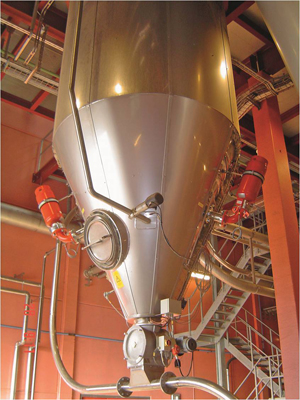
Application
Dust collectors are used both as receiving vessels and for the collection of dust. They separate dust from the air stream by employing an array of filter bags or filter cartridges. Dust-laden air slows down as it enters the collector, shedding some of its dust load into the collection hopper which empties via a rotary gate valve. The lighter dust is swept up into the filter components from which it is periodically removed by air blasts or by a shaker mechanism.
Hazard
If the material being handled by a process is combustible, then the dust it generates is likely to be explosive. Dust collectors collect the finest and therefore the most easily ignited dust in a process. For this reason, dust collectors are the most commonly protected process vessels. Many dust collectors handle dust loadings that are below the explosible limit. However, in the period during which the filter components are cleaned, either by shaking or by reverse jets of air, explosible concentrations can be reached. Under these conditions, an ignition source is all that is required to trigger a combustible dust explosion. This can be provided by static electricity or by incoming burning particles from upstream equipment such as mills or dryers. In addition to damaging the dust collector, the deflagration may propagate to connected equipment. NFPA 654 requires that deflagration isolation be considered to stop flame propagation between interconnected vessels.
Protection System Considerations
Protection systems for cyclones must accommodate the need to maintain a smooth inside vessel wall for efficient cyclone performance. IEP Technologies suppression systems achieve this by using flush spreader assemblies for suppressant dispersal.
Protection System Description
For dust collectors mounted outside or close to an outside wall, explosion relief venting is a viable protection method. Protection is provided by an explosion relief vent that ruptures at pre-determined burst pressure to relieve pressure caused by a deflagration. For process equipment that is indoors and not close to an outside wall, flameless vents become a viable option. With flameless vents, the flame is arrested and the gasses are cooled as they pass through a stainless steel mesh.
A dust collector is frequently located inside the plant, making protection by explosion relief venting often impractical. The solution is an explosion suppression system. In such a system, explosion pressure detectors mounted on the collector detect the initial pressure excursion from an incipient explosion. The detectors transmit a signal to a control panel, which triggers high rate discharge extinguishers while simultaneously shutting down the process. Extinguishers mounted on the collector rapidly discharge suppressant to quench the fireball before destructive pressures are reached. An isolation extinguisher mounted on the inlet duct prevents flashback upstream to interconnected process equipment.


